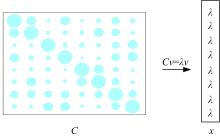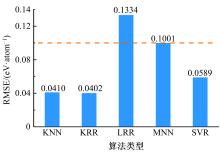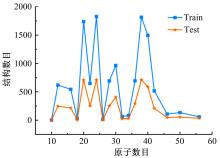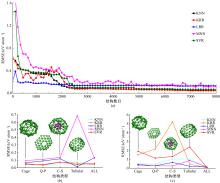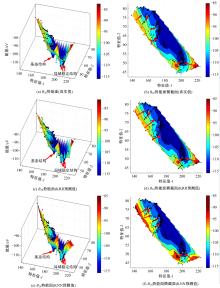Journal of Jilin University(Engineering and Technology Edition) ›› 2021, Vol. 51 ›› Issue (2): 667-676.doi: 10.13229/j.cnki.jdxbgxb20191070
Accelerating CALYPSO structure prediction with machine learning
Xiao-hui WEI1( ),Chang-bao ZHOU1,Xiao-xian SHEN1,Yuan-yuan LIU1,Qun-chao TONG2
),Chang-bao ZHOU1,Xiao-xian SHEN1,Yuan-yuan LIU1,Qun-chao TONG2
- 1.College of Computer Science & Technology,Jilin University,Changchun 130012,China
2.State Key Lab of Superhard Materials,Jilin University,Changchun 130012,China
CLC Number:
- TP399
| 1 | Hansen K, Montavon G, Biegler F, et al. Assessment and validation of machine learning methods for predicting molecular atomization energies[J]. Journal of Chemical Theory and Computation, 2013, 9(8): 3404-3419. |
| 2 | Doye J P, Wales D J. Structural consequences of the range of the interatomic potential a menagerie of clusters[J]. Journal of the Chemical Society, Faraday Transactions, 1997, 93(24): 4233-4243. |
| 3 | Salamat A, Garbarino G, Dewaele A, et al. Dense close-packed phase of tin above 157 GPa observed experimentally via angle-dispersive x-ray diffraction[J]. Physical Review B, 2011, 84(14): 140104. |
| 4 | Wang Y C, Lv J, Zhu L, et al. Crystal structure prediction via particle-swarm optimization[J]. Physical Review B, 2010,82(9):094116. |
| 5 | Wang Y C, Lv J, Zhu L, et al. CALYPSO: A method for crystal structure prediction[J]. Computer Physics Communications, 2012, 183(10): 2063-2070. |
| 6 | Lv J, Wang Y C, Zhu L, et al. Particle-swarm structure prediction on clusters[J]. The Journal of Chemical Physics, 2012, 137(8): 084104. |
| 7 | Tadmor E B, Miller R E. Modeling Materials: Continuum, Atomistic and Multiscale Techniques[M]. Cambridge: Cambridge University Press, 2011. |
| 8 | 赵东, 臧雪柏, 赵宏伟. 基于果蝇优化的随机森林预测方法[J]. 吉林大学学报: 工学版, 2017, 47(2): 609-614. |
| Zhao Dong, Zang Xue-bai, Zhao Hong-wei. Random forest prediction method based on optimization of fruit fly[J]. Journal of Jilin University (Engineering and Technology Edition), 2017, 47(2): 609-614. | |
| 9 | Tong Q C, Xue L T, Lv J, et al. Accelerating CALYPSO structure prediction by data-driven learning of potential energy surface[J]. Faraday Discussions, 2018, 211: 31-43. |
| 10 | 张耀龙, 周雪瑶, 蒋彬. 加速神经网络势能面的构建:一种杂化的训练算法[J]. 化学物理学报, 2017, 30(6): 727-734. |
| Zhang Yao-long, Zhou Xue-yao, Jiang Bin. Accelerating the construction of neural network potential energy surfaces: a fast hybrid training algorithm[J]. Chinese Journal of Chemical Physics, 2017, 30(6):727-734. | |
| 11 | Zhang L F, Han J Q, Wang H, et al. Deep potential molecular dynamics: a scalable model with the accuracy of quantum mechanics[J]. Physical Review Letters, 2018,120(14): 143001. |
| 12 | Marsland S. Machine Learning: An Algorithmic Perspective[M]. Chapman and Hall/CRC, 2011. |
| 13 | Behler J, Parrinello M. Generalized neural-network representation of high-dimensional potential-energy surfaces[J]. Physical Review Letters, 2007, 98(14): 146401. |
| 14 | Bartók A P, Payne M C, Kondor R, et al. Gaussian approximation potentials: the accuracy of quantum mechanics, without the electrons[J]. Physical Review Letters, 2010, 104(13): 136403. |
| 15 | Snyder J C, Rupp M, Hansen K, et al. Finding density functionals with machine learning[J]. Physical Review Letters, 2012, 108(25): 253002. |
| 16 | Cui J, Krems R V. Gaussian process model for collision dynamics of complex molecules[J]. Physical Review Letters, 2015, 115(7): 073202. |
| 17 | Hoerl A E, Kennard R W. Ridge regression: biased estimation for nonorthogonal problems[J]. Technometrics, 1970, 12(1): 55-67. |
| 18 | Vovk V. Kernel Ridge Regression[M].Empirical Inference, Springer, 2013. |
| 19 | Smola A J, Schölkopf B. A tutorial on support vector regression[J]. Statistics and Computing, 2004, 14(3): 199-222. |
| 20 | 王刚, 刘元宁, 陈慧灵, 等. 粗糙集与支持向量机在肝炎诊断中的应用[J]. 吉林大学学报: 工学版, 2011, 41(1): 160-164. |
| Wang Gang, Liu Yuan-ning, Chen Hui-ling, et al. Application of rough set and support vector machines in hepatitis diagnosis[J]. Journal of Jilin University (Engineering and Technology Edition), 2011, 41(1): 160-164. | |
| 21 | Heidari A A, Faris H, Mirjalili S, et al. Ant Lion Optimizer: Theory, Literature Review, and Application in Multi-layer Perceptron Neural Networks[M].Nature-Inspired Optimizers, Springer, 2020. |
| 22 | Biau G, Devroye L. Lectures on the Nearest Neighbor Method[M]. Springer, 2015. |
| 23 | 沈艳芳, 徐畅, 黄敏, 等. 硼团簇、硼烷及金属硼化物的研究现状[J]. 化学进展, 2016, 28(11): 1601-1614. |
| Shen Yan-fang, Xu Chang, Huang Min, et al. Research advances of boron clusters, borane and metal-doped boron compounds[J],Progress in Chemistry, 2016, 28(11): 1601-1614. | |
| 24 | Rupp M, Tkatchenko A, Müller K, et al. Fast and accurate modeling of molecular atomization energies with machine learning[J]. Physical Review Letters, 2012, 108(5): 058301. |
| [1] | Ming FANG,Wen-qiang CHEN. Face micro-expression recognition based on ResNet with object mask [J]. Journal of Jilin University(Engineering and Technology Edition), 2021, 51(1): 303-313. |
| [2] | Yuan SONG,Dan-yuan ZHOU,Wen-chang SHI. Method to enhance security function of OpenStack Swift cloud storage system [J]. Journal of Jilin University(Engineering and Technology Edition), 2021, 51(1): 314-322. |
| [3] | Xiao-yu WANG,Xin-hao HU,Chang-lin HAN. Face pencil drawing algorithms based on generative adversarial network [J]. Journal of Jilin University(Engineering and Technology Edition), 2021, 51(1): 285-292. |
| [4] | Xiang-jiu CHE,You-zheng DONG. Improved image recognition algorithm based on multi⁃scale information fusion [J]. Journal of Jilin University(Engineering and Technology Edition), 2020, 50(5): 1747-1754. |
| [5] | Hong-wei ZHAO,Xiao-han LIU,Yuan ZHANG,Li-li FAN,Man-li LONG,Xue-bai ZANG. Clothing classification algorithm based on landmark attention and channel attention [J]. Journal of Jilin University(Engineering and Technology Edition), 2020, 50(5): 1765-1770. |
| [6] | Nai-yan GUAN,Juan-li GUO. Component awareness adaptive model based on attitude estimation algorithms [J]. Journal of Jilin University(Engineering and Technology Edition), 2020, 50(5): 1850-1855. |
| [7] | Yang LI,Shuo LI,Li-wei JING. Estimate model based on Bayesian model and machine learning algorithms applicated in financial risk assessment [J]. Journal of Jilin University(Engineering and Technology Edition), 2020, 50(5): 1862-1869. |
| [8] | Bing-hai ZHOU,Zhao-xu HE. Dynamic material handling scheduling for mixed⁃model assembly lines based on line⁃integrated supermarkets [J]. Journal of Jilin University(Engineering and Technology Edition), 2020, 50(5): 1809-1817. |
| [9] | Lei JIANG,Ren-chu GUAN. Design of fuzzy comprehensive evaluation system for talent quality based on multi⁃objective evolutionary algorithm [J]. Journal of Jilin University(Engineering and Technology Edition), 2020, 50(5): 1856-1861. |
| [10] | Zhou-zhou LIU,Wen-xiao YIN,Qian-yun ZHANG,Han PENG. Sensor cloud intrusion detection based on discrete optimization algorithm and machine learning [J]. Journal of Jilin University(Engineering and Technology Edition), 2020, 50(2): 692-702. |
| [11] | Xiao-hui WANG,Lu-shen WU,Hua-wei CHEN. Denoising of scattered point cloud data based on normal vector distance classification [J]. Journal of Jilin University(Engineering and Technology Edition), 2020, 50(1): 278-288. |
| [12] | Xiao-dong ZHANG,Xiao-jun XIA,Hai-feng LYU,Xu-chao GONG,Meng-jia LIAN. Dynamic load balancing of physiological data flow in big data network parallel computing environment [J]. Journal of Jilin University(Engineering and Technology Edition), 2020, 50(1): 247-254. |
| [13] | Man CHEN,Yong ZHONG,Zhen-dong LI. Multi-focus image fusion based on latent low⁃rank representation combining low⁃rank representation [J]. Journal of Jilin University(Engineering and Technology Edition), 2020, 50(1): 297-305. |
| [14] | Shun-fu JIN,Xiu-chen QIE,Hai-xing WU,Zhan-qiang HUO. Clustered virtual machine allocation strategy in cloud computing based on new type of sleep-mode and performance optimization [J]. Journal of Jilin University(Engineering and Technology Edition), 2020, 50(1): 237-246. |
| [15] | Jun-yi DENG,Yan-heng LIU,Shi FENG,Rong-cun ZHAO,Jian WANG. GSPN⁃based model to evaluate the performance and securi tytradeoff in Ad-hoc network [J]. Journal of Jilin University(Engineering and Technology Edition), 2020, 50(1): 255-261. |
|
||








